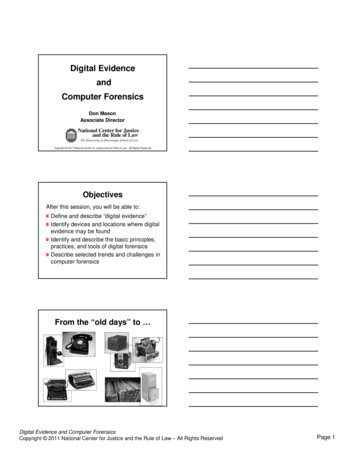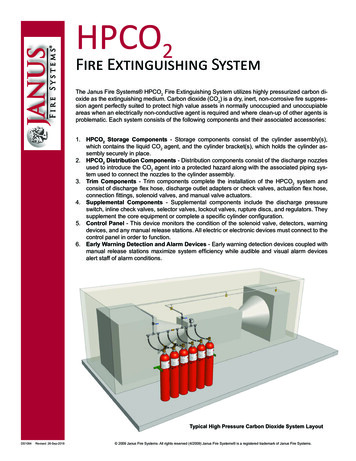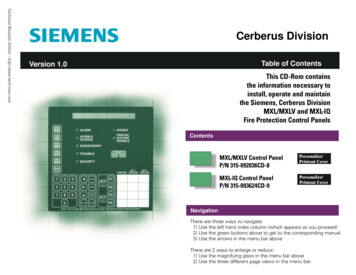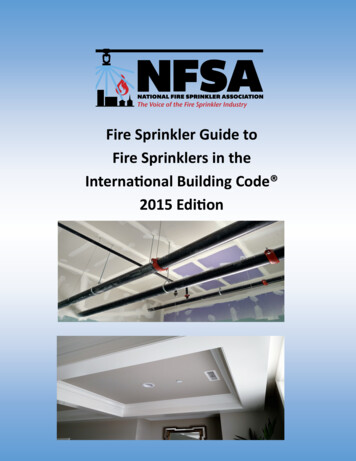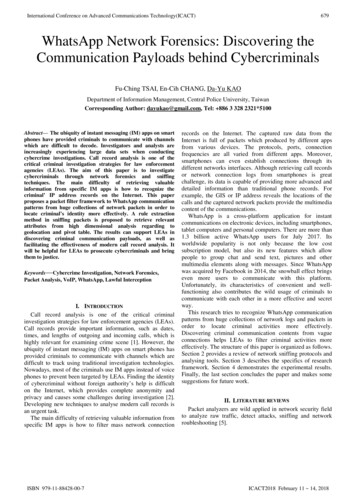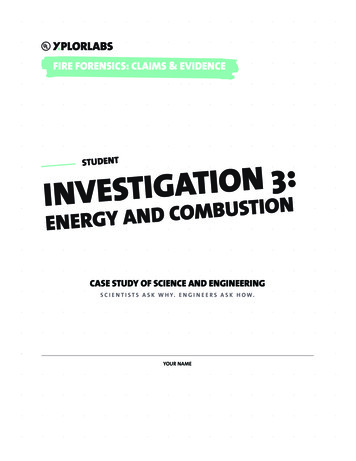
Transcription
FIRE FORENSICS: CLAIMS & EVIDENCE:3NOITAGITSEVINNSTUDENTOITSUBMOCENERGY ANDCASE STUDY OF SCIENCE AND ENGINEERINGS C I E N T I S T S A S K W H Y. E N G I N E E R S A S K H O W.YOUR NAME
Enduring understanding: To investigate a fire, we must first understand ignition and combustion principles.To solve a case, we must understand how to build a claim supported by evidence and reason.INVESTIGATION 3: ENERGY AND COMBUSTIONNote: Includes video of fire and fire-related data; optional burn of small materials in controlled lab setting.FIRE INVESTIGATORS MUST UNDERSTAND: Heat of combustion from different common household materialsWhen fire investigators know how different fuels ignite and combust, they can better understand a burnscene and can build stronger claims based on knowledge of types of evidence and patterns of fuels.Exploration: What is heat of combustion (HoC) and how is it measured?The TESTABLE question guiding our investigations is:Does the material the fuel is made of effect the amount of energy released during combustion?SUMMARY OF LABUsing a video of our UL fire expert in the fire research lab, you will make observations of the timing, behavior,and smoke of different fuels as they burn. Then, build a calorimeter or continue with the video as one is builtin the lab to measure the heat and energy stored in common household materials.eXPLORING THE ISSUEIn previous Fire Forensics investigations, we learned that only gases burn because fire is a gas-phase chemicalreaction. Solids do not burn in solid form. When a solid is heated, it gives off fuel gases which are flammable.This process is called pyrolysis.We also learned that synthetic materials burn a lot faster than organic materials. We learned that the massand density of materials may enable them to ignite and burn at different rates – meaning that we canchange how easy it is (or how much energy is required) to ignite a material, like wood, based on the shapeand size of the wood, or the form that the wood is in. This is called the surface-to-mass ratio.In this investigation, we want to investigate the heat released when different fuels burn, and measure theheat released by household materials and foods using a process and calculation for the heat of combustion.2
HEAT RELEASED AND HEAT OF COMBUSTIONWhat’s the difference between temperature and heat? According to the National Fire Protection Association(NFPA),o Temperature: The degree of sensible heat of a body as measured by athermometer or similar instrument.o Heat: A form of energy characterized by vibration of molecules and capable ofinitiating and supporting chemical changes and changes of state.Heat of combustion is the energy released from a fuel while it is burning. This is a primary differencebetween heat and temperature. For example, think of a candle flame and a campfire or fire in a fireplace. Theflames of different sizes may be the same temperature, but the energy released is different. In addition tothe potential energy of the material, the amount of energy released is also based on the oxygen consumedduring combustion.When you eat food, your body burns calories – or the potential energy stored in the food. You breathe inoxygen, then oxidize and digest the food you consumed. Your body moves around and sweats because youare hot, generating heat and burning the calories you consumed. Some foods are more efficient fuel thanothers.Fire is a rapid oxygenation process that gives off a relative amount of heat. The calorimeter is a simple toolused to measure the heat released by burning objects – both food and common objects found in homes andbuildings.To determine the HoC of a fuel (material), we can use a simple calorimeter. A calorimeter measures theenergy released during a chemical reaction (fire) or phase change (in objects like food or a household item).The material or sample being burned is the fuel. The fuel is releasing energy as it burns under the can. Thistransfer of energy is mostly due to convection – the energy from the hot gases are transferred to the can viaconvective heat transfer. The can transfers the energy to the water and we can measure the temperaturechange of the water. When the flame touches the can, it is a conductive heat transfer. The light energy fromthe flames to the can is radiation heat transfer.Everything burned in this investigation is found in homes, including woods and food. Fire investigators needto know how different common household items burn so when they arrive at a fire scene and enter a roomwhere everything is rubble, they can sift through the debris and determine what was on fire, how it burned,and understand the patterns of the burn scene around them. When fire investigators investigate theevidence left behind from different fuels, they have to know how the fuels reacted in the fire, if they wereinsulators or conductors of heat, and how to use this information to trace back to what the fuel was thatburned.The rate of ignition is the speed and ease that the object catches on fire. Understanding the rate of ignitionand combustion of common household items helps make safer spaces. Materials may have a different rate ofignition and burning depending on if they are organic or synthetic items. Furniture made of wood will be adifferent kind of fuel source than furniture made of foam plastic or synthetic upholstery (this is what welearned in Investigation 2, part B).3
Part A. eXPLORATIONTestable question:Does the material the fuel is made of effect the amount of energy released duringcombustion?MATERIALS(one set per group of students or one set for teacher’s demonstration)Investigation 3 VideoStudent Xplorlab pagesBeaker or soda canGraduated cylinder (to measure water)Water (50 mL 50 g)Small digital thermometerBeaker stand (to hold beaker) or ring stand (to hold can)Paper clip or straight pinCorkAssortment of real fuels found in the interior of a home(LIST FUELS SELECTED FOR YOUR LAB HERE):ooooo4
OR Assortment of food items(LIST FOODS SELECTED FOR YOUR LAB HERE):oooooGROUP ROLES (2-4 students)THE STUFF SUPERVISORTHE EXPERIMENT EXECTHE DIRECTOROF DOCUMENTSTHE PRINCIPALPRESENTERGathers and cleans upmaterialsRuns the experimentReads the procedure to thegroup and helps the groupmembers with datacollectionShares the group’s workwith the rest of the classPROCEDUREPrepare materials by weighing each material – record starting mass of each material/fuel.Make a prediction about the object’s stored energy: will it have a higher HoC or a lower HoC than the otherobjects? Why?1. Pour 50 mL of water into soda can or beaker. (Table 1 will ask for the mass of water in grams.Hint: 1 mL 1 g. mL is a unit of measurement for volume; g is a unit of measurement for mass.)2. Use a paper clip to create a stand for the sample.3. Record the name of Sample 1 fuel/material (object burned) and its mass in grams in the data table.4. Place Sample 1 on the paper clip securely so that the cork balances and isn’t easily knocked over. Place thisitem in the center of a metal jar lid or on a non-flammable surface in case it is knocked over.5. Place the can into a ring stand or beaker into beaker stand and lower the bottom of the can 1 inch from theSample 1.5
6. Take a starting temperature of the water in the can and record the temperature in Table 1.7. Be sure there is nothing flammable surrounding the set up and check that sleeves are rolled up and hairtied back.8. Hold the long reach lighter flame to Sample 1 and ignite Sample 1.9. Observe the rate and burn including flame spread, smoke, and speed of combustion. Record observationsin the data table.10. Once the sample is completely burned, record the temperature reading in degrees Celsius after it hasstopped rising (peak water temperature) and record in Table 1.*Use caution! Things will be hot!11. Weigh the object with consideration for the weight of the paper clip.12. To calculate the HoC of Sample 1, first calculate the heat absorbed by water. You will use this result in theHoC equation in Table 2. Heat absorbed by water (heat released in calories) mass of water (g) X specificheat of water (cal/g C) X change in temperature (C).Table 1. Heat absorbed by the water (or, heat released)Objectburned(Sample #)Example:MarshmallowStartingmass ofobject (g)1gMass ofwater(g)Startingtemp ofwater( C)50 g28 CPeakwatertemp ( C)37.2 CTempincrease( C)9.2 CHeat absorbed bywater (cal) heatreleased (cal)heat released (cal) massof water (g) * specific heatof water (cal/g C) * changein temperature (C)Observations ofsample duringcombustion460 cal*1 calorie/gram C or 4.186 joule/gram C6
13. To calculate the heat of combustion, complete Table 2. Enter the values for:Heat absorbed by water (from Table 1),the beginning mass of the object before burning,the mass of the object after burning,mass loss found by caluclating the difference between the beginning mass and mass after burning.Calculate the heat of combustion using the equation: Heat of Combustion HoC Heat absorbed bywater (heat released)(Cal) / mass consumed (g)Table 2. Heat of Combustion (HoC)Objectburned(Sample #)Heat absorbed bywater (cal) heatreleased (cal)Beginning mass(g) of sampleMass ofsample afterburning (g)Mass loss ofsample (g) massconsumed (g)6g0.85 gFrom Table 1Example:Marshmallow460 cal6.85 gHeat of combustion(cal/g)Heat of CombustionHoC Heat released(Cal) / massconsumed (g)541 cal/g*Let temp equalize/return to room temp/starting temp between each burn – does not have to be exact ascalculating relative temp.14. Using lab tongs, empty water from can into sink and add another 50 mL of water OR use a new can with50 mL of fresh water.15. Repeat entire procedure with samples 2-5.7
Table 1. Heat releasedObjectburned(Sample #)Example:MarshmallowStarting massof object (g)Mass ofwater incan(g)Startingtemp ofwater ( C)Peak watertemp ( C)Tempincrease ( C)50 g28 C37.2 C9.2 C1gHeat absorbed bywater (cal) heatreleased (cal)heat released (cal) mass ofwater (g) * mass of water in can* change in temperature (C)460 cal1.2.3.4.Table 2. Heat of Combustion (HoC)Objectburned(Sample #)Heat absorbed bywater (cal) heatreleased (cal)Beginning mass(g) of sampleMass ofsample afterburning (g)Mass loss ofsample (g) massconsumed (g)6.85 g6g0.85 gFrom Table 1Example:Marshmallow460 calHeat of combustion(cal/g)Heat of CombustionHoC Heat released(Cal) / massconsumed (g)541 cal/g1.2.3.4.8
CLAIMS / EVIDENCE / REASONINGDoes material effect the heat of combustion (HoC)?Based on our measurements in this investigation, what can we claim about the effect of material types onthe amount of heat energy released during combustion?What is our evidence for these claims?What is our reasoning for the evidence?Why is this important for fire investigators to understand?9
energy released during a chemical reaction ( re) or phase change (in objects like food or a household item). The material or sample being burned is the fuel. The fuel is releasing energy as it burns under the can. This transfer of energy is

